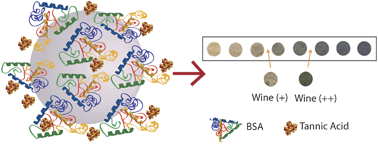Protein–polyphenol interaction on silica beads for astringency tests based on eye, photography or reflectance detection modes†
Abstract
Astringency is an organoleptic property of beverages and

Maintenance work is planned for Wednesday 1st May 2024 from 9:00am to 11:00am (BST).
During this time, the performance of our website may be affected - searches may run slowly and some pages may be temporarily unavailable. If this happens, please try refreshing your web browser or try waiting two to three minutes before trying again.
We apologise for any inconvenience this might cause and thank you for your patience.
* Corresponding authors
a
BioMark Sensor Research/Instituto Superior de Engenharia do Instituto Politécnico do Porto, Rua Dr António Bernardino de Almeida, 431, 4200-072 Porto, Portugal
E-mail:
goreti.sales@gmail.com, mgf@isep.ipp.pt
Fax: +351 228 321 159
Tel: +351 228 340 500
b Departamento de Química, Faculdade de Ciências, Centro de Investigação em Química, Universidade do Porto, Rua do Campo Alegre 687, 4169-007 Porto, Portugal
c iNANO Center, Aarhus University, Aarhus DK-8000, Denmark
Astringency is an organoleptic property of beverages and

 Please wait while we load your content...
Something went wrong. Try again?
Please wait while we load your content...
Something went wrong. Try again?
J. R. L. Guerreiro, D. S. Sutherland, V. De Freitas and M. G. F. Sales, Anal. Methods, 2013, 5, 2694 DOI: 10.1039/C3AY26478E
To request permission to reproduce material from this article, please go to the Copyright Clearance Center request page.
If you are an author contributing to an RSC publication, you do not need to request permission provided correct acknowledgement is given.
If you are the author of this article, you do not need to request permission to reproduce figures and diagrams provided correct acknowledgement is given. If you want to reproduce the whole article in a third-party publication (excluding your thesis/dissertation for which permission is not required) please go to the Copyright Clearance Center request page.
Read more about how to correctly acknowledge RSC content.
 Fetching data from CrossRef.
Fetching data from CrossRef.
This may take some time to load.
Loading related content
